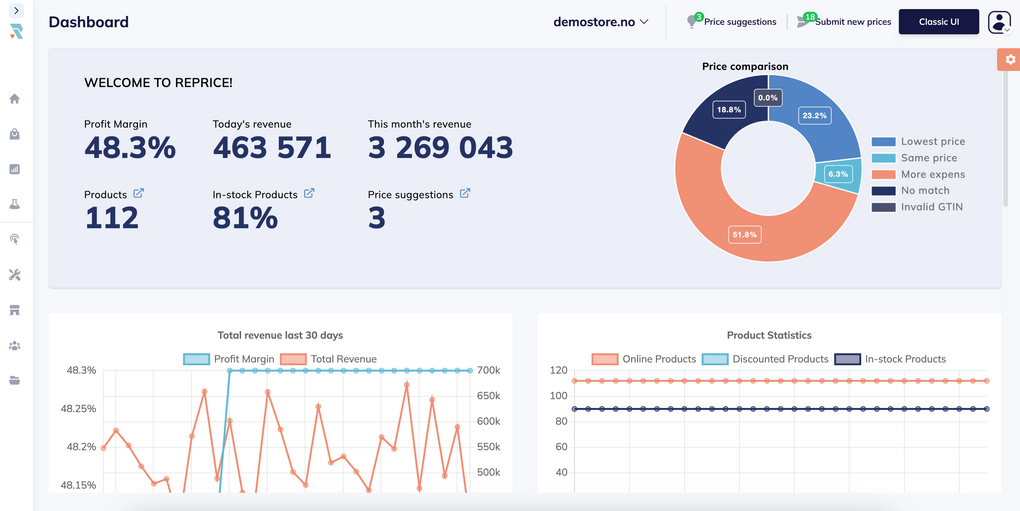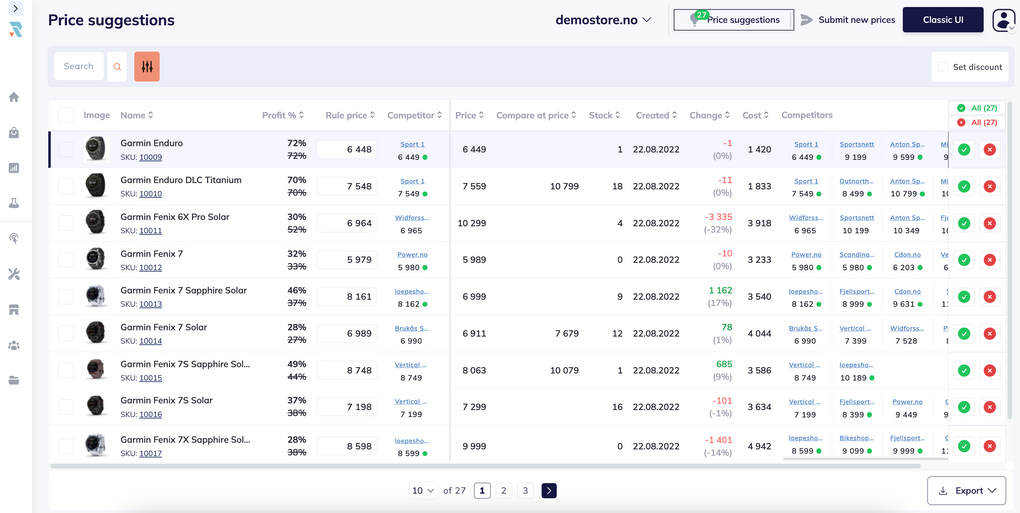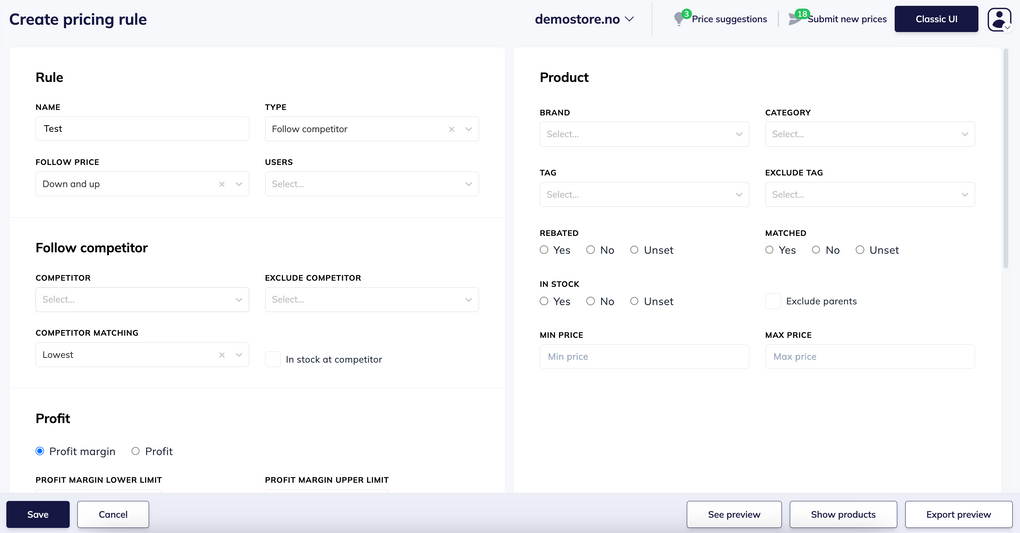Expanding your e-commerce business into new markets is a huge chance to grow. But it's not enough to just show up.
You have to stand out too.
In this guide, we’ll explain how you can set more strategic prices for new markets. Whether that’s by implementing dynamic pricing or conducting market research, this article delves into how to make your mark successfully.
It's not all about making more money. It's about building strong relationships with new customers who'll keep coming back, talk up your brand, and turn into loyal fans.
And smart, strategic pricing isn't just a tactic: it's your key to winning over customers and boosting your business as you expand.
In this article:
- Why expanding to new markets is key for e-commerce growth
- 7 strategies for e-commerce pricing optimization in new markets
- Maximizing customer loyalty as you expand into new markets
- Conclusion
Why expanding to new markets is key for e-commerce growth
The e-commerce industry grew immensely during the The COVID-19 pandemic, and it’s only kept going. In fact, global internet sales reached an astounding $5.8 trillion in 2023.
And as the e-commerce landscape continues to expand, worldwide revenues are projected to reach $8.0 trillion by 2027. This means there’s significant opportunities for e-commerce companies looking to get their foot into new markets.
Here's a few reasons why expanding into new markets is beneficial:
- You grow your income streams: Exploring new markets allows companies to broaden their income sources, which makes them less dependent on any single market. This can lower risks and lays the groundwork for steady growth moving forward.
- There’s access to new diverse customer segments: New markets open doors to different customer groups - all with different preferences and needs. This is a chance to broaden your customer base and cater to a wider (aka larger) audience.
- Experience increased brand awareness and presence: Expanding your market reach naturally boosts your brand's visibility, as you’re getting seen by new customers. It’s an easily achievable step towards building a more recognizable and influential global brand.
- Make more use of global e-commerce trends: By tapping into global markets, companies can stay ahead by adopting and capitalizing on emerging e-commerce trends worldwide, like sustainable shopping or increased personalization. That means they can innovate faster, meet all types of customer needs much more effectively, and at the same - time outpace competitors.
- You gain a competitive advantage: Entering new, possibly less saturated markets can give businesses a competitive edge. Which then allows them to establish a strong foothold before others.
- Constant adaptation and innovation: Learning from different markets sparks new ideas and changes. This can result in better products and services, made just right for what each market needs.
- It’s a better response to market saturation: When local markets get too crowded, moving into new arenas can be a smart way to keep growing and avoid any form of stagnation.
- There’s long-term sustainability: Going head first into multiple markets contributes to the long-term resilience and sustainability of a business. In other words, shielding it against market fluctuations.
7 strategies for e-commerce pricing optimization in new markets
Diving into new markets requires a smart, data-driven approach to pricing.
In that case, here are 7 strategies to use in order to improve your pricing, once you’ve taken the foot into new territories:
1. Leverage pricing technology and tools for quick adaptability
Leveraging the latest technology can be highly beneficial when adapting your pricing strategies in new markets. Using pricing software like Reprice can help you determine optimal pricing strategies through advanced algorithms and machine learning.
Example: A key feature of Reprice is its integrated dashboard. With the Reprice dashboard, you have access to a fully integrated system. This allows you to generate reports and view key statistics based on a wide range of data sources.
This integration is invaluable for internal use. Why? Because it replaces the need to log into multiple tools for sales and revenue reports. Which is time-consuming and leaves room for confusion.
And since Reprice consolidates all essential data in one user-friendly location, you streamline your workflow and make it your primary tool for informed pricing decisions in new markets.

2. Conduct new market research and analysis
Navigating new markets means understanding the lay of the land. It’s key to tackle this smartly.
Start by sizing up your competitors' pricing. It's not just about numbers; it’s about context. Seeing how they price similar products gives you a clear benchmark and helps you guide your strategy.
Next, assess customer demand and price sensitivity. It’s key to grasp how price changes affect their choices. Because this isn’t just about data and numbers; it's about understanding your customers’ attitudes towards spending and the value they’re getting.
Also, it’s key to consider the broader economic landscape. We’re talking about factors like average incomes, currency trends, and purchasing power. They aren’t just stats - they can actually shape your entire pricing strategy.
This is where tools like Reprice step in. It offers real insights into your competitors’ pricing and strategies, helping you find your niche or edge.
Plus, it also includes daily price recommendations based on market trends. Product pricing changes rapidly, and with Reprice, you'll receive suggestions aligned with your pricing rules. Each recommendation requires approval before going live, ensuring you stay in control.

3. Analyze your costs
When expanding to new markets, a critical step is understanding and managing your costs. After all, unexpected expenses can quickly eat into profits. And a more strategic, efficient cost management makes sure you get the most out of what you earn - while still efficiently navigating your new market entry.
First, it would be smart to calculate the Cost of Goods Sold (COGS). This includes all the direct costs associated with producing your products for the new market. It's not just about the price tag, it's about the whole process from production to sale.
Next, it could be smart to consider your operational costs. These go beyond production – think shipping, taxes, duties, and any other expenses unique to the market. That way you see the full financial picture.
Once you’ve analyzed your costs and have a clear understanding of your financial landscape, tools like Reprice step in to ensure that your pricing strategy aligns seamlessly with your cost calculations.
For example, by synchronizing pricing data across various sales channels, including e-commerce platforms like Shopify, Magento, and WooCommerce, as well as physical stores, Reprice guarantees consistent pricing strategies, allowing you to maintain price uniformity and maximize profitability across all markets.
That way you maintain price uniformity once you've crunched your cost numbers. It’s about keeping your pricing strategy synchronized and streamlined, regardless of where your products are sold.
4. Implement dynamic pricing strategies
Dynamic pricing is crucial for staying agile and up-to-speed in new markets, because it allows you to adjust your prices based on competition, market conditions and demand (all in real-time).
Adapt your prices according to seasonality, local events, and changing customer demand patterns to stay in tune with the market's rhythm. Reprice helps you implement your dynamic pricing strategy, offering both manual and automatic adjustments based on specific rules you set.
For example, you can set pricing rules according to various criteria like "brand," "category," or "tag" for any designated products. Additionally, you can customize rules based on factors like "follow competitor X," "minimum margin," or "adjust price up and down" to tailor your pricing strategy precisely to what you need.
That way it's easy to make real-time pricing adjustments as you go - using current market data, making sure that your pricing always stays relevant and competitive, no matter which market you’re in.

5. Stay in line with regulatory and legal considerations
When entering new markets, it's crucial to follow the local regulations and understand how taxes affect your pricing strategies. You probably want to avoid the pitfalls of any legal issues, or facing any unexpected costs that can hurt your profits.
For example, Norway's new regulations, effective from October 1, 2023, underline the importance of transparent pricing and enhanced consumer protection, in line with EU Directive 2019/2161.
These rules say that businesses need to set discount prices based on the lowest price over the past 30 days, factor in loyalty program offers into the base price, and transparently communicate personalized pricing practices.
Following these rules and standards not only builds consumer trust. They also safeguard against legal penalties, encourage fair competition, and ensure consistency with European norms.
And using tools like Reprice can simplify this compliance, automating discount calculations to seamlessly align with these requirements, which is crucial for success when stepping into new markets.
6. Use customer feedback and surveys to improve
A surefire way to understand your new market is by listening directly to your customers. It’s simple: Run surveys and ask for feedback.
This way, you’ll know exactly what your customers are willing to pay. It’s like having a direct line to what they need and value. Plus, keeping it straightforward and transparent helps you craft pricing that hits the mark, in other words, making sure you’re spot on with your pricing strategy.
7. Always test and adapt
Always experiment and refine your approach with A/B testing to identify the most effective pricing strategy for your market. The reason being is that it's crucial to continuously monitor market reactions and be prepared to adjust your pricing strategies accordingly.
With Reprice, you can make selective manual pricing updates and create custom rules.
This gives you the flexibility needed to experiment with various pricing strategies, in other words, making A/B testing a breeze. And by adapting pricing based on market feedback, you can pinpoint the optimal pricing strategy for new markets.

Maximizing customer retention as you expand into new markets
In e-commerce, success relies as much on keeping existing customers as it does on pulling in new ones.
A slight uptick in customer retention can boost profits significantly because loyal customers usually spend more and cost less to keep, reducing marketing expenses.
But the true key to customer loyalty? Dynamic and competitive pricing. With pricing tools, companies can easily adjust their pricing to reflect accurate market trends and consumer preferences.
Taking into account regular feedback from customers is also important. It helps tweak your products and services (and pricing) that actually makes your customers happy, satisfied and keeps them coming back for more.
Efficient product management is essential too. Insights from Reprice ensure that what you offer meets market demand, keeping customers interested.
Plus, integrating Reprice with your core business platforms streamlines your pricing operations and ensures consistent pricing, which helps boost the customer experience from exposure to purchase.
Conclusion
All in all: Diving into new markets is crucial for e-commerce growth. Using tools like Reprice is crucial to get started with setting those new, competitive prices.
It’s clear that adapting pricing strategies based on real-time insights is key to staying competitive - and that your business remains aligned with customer expectations and market trends.
Ready to get started with Reprice? Book a demo here.
Robin Frugaard Jørgensen
Chief Commercial Officer at Reprice
Robin Frugaard Jørgensen is Chief Commercial Officer at Reprice. Prior to joining Reprice in January 2023, Robin spent several years working with pricing strategies in B2B & the consumer electronics industry. Connect with Robin on LinkedIn here or book a demo to see how Reprice can solve your e-commerce pricing challenges.
